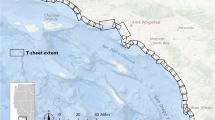Abstract
Coastal wetlands are a valuable resource to North Carolina, USA, representing important habitat for marine organisms and providing flood control areas and buffer zones from marine storms. An analysis of wetland development trends in coastal North Carolina from 1970 to 1984 was conducted using over 3000 files containing 15 years of permitting records. The total amount of coastal wetland area altered due to authorized development under the Coastal Area Management Act (CAMA), the Dredge and Fill Law, and Section 404 of the Federal Water Pollution Control Act is 1740 ha. This represents nearly 2% of the salt marsh wetlands along the coast of North Carolina. The number of permits issued steadily increased during the 1980s; however, the total amount of wetland loss decreased each year. A few large projects in the early 1970s accounted for nearly 70% of all wetland area developed during the 15-year period. Nearly two-thirds of all projects involving wetland destruction involved impacts on high marsh ecosystems. Bulkheads, canals, and filling activities made up 80% of the projects requiring permits; 62% of the permits were issued to private landowners, but this group accounted for only 16% of the losses of wetland area. Utility companies, which accounted for less than 1% of the permits issued, were responsible for 46% of the permitted wetland loss during the 15-year study period. Future studies should address agriculture and forestry practices which are exempt under CAMA laws and therefore their effects on wetland alteration have not been quantified.
Similar content being viewed by others
Literature cited
Carteret County Land Use Atlas. 1982. Prepared by the Division of Coastal Management, Raleigh, North Carolina.
Cowardin, L. M., V. Carter, F. C. Golet, and E. T. Laroe. 1979. Classification of wetlands and deepwater habitats of the United States. US Fish and Wildlife Service, OBS-79/ 31.
Finger, B., and B. Jacobs. 1982. Coastal management.North Carolina Insight 5:2–13.
Greeson, P. E., J. R. Clark, and J. E. Clark (eds.). 1979. Wetland functions and values: the state of our understanding. American Water Resources Association, Minneapolis, Minnesota.
Hawley, A. J. 1974. The present and future status of eastern North Carolina wetlands. Water Resources Research Institute, University of North Carolina, Chapel Hill, North Carolina, no. 87.
Heath, M. S., Jr. 1978. General background: an overview of the North Carolina Coastal Area Management Act. Institute of Government, University of North Carolina, Chapel Hill, North Carolina.
Heath, M. S., Jr. 1980. The Coastal Area Management Act: a progress report. Popular Government, vol. 45, no. 4. Institute of Government, University of North Carolina, Chapel Hill, North Carolina.
Heath, M. S., Jr. 1981. Political economy of alternative management strategies for pocosins in North Carolina. Pages 305–317in C. J. Richardson (ed.), Pocosin wetlands. Hutchinson Ross.
Hefner, J. M., and J. D. Brown. 1985. Wetland trends in the southeastern United States. Wetlands 4:1–12.
Jones, R. L., Jr. 1982. Coastal zone and wetlands legislation in southern states: its impact on private commercial forestry. Unpublished Master's project, Duke University School of Forestry and Environmental Studies, Durham, North Carolina.
Odum, W. E., M. L. Dunn, and T. J. Smith. 1979. Habitat value of tidal fresh water wetlands. Pages 248–266in P. E. Greeson, J. R. Clark, and J. E. Clark (eds.), Wetland functions and values: the state of our understanding.
Office of Technology Assessment. 1984. Wetlands: their use and regulation. US Congress, OTA-0-206, Washington, DC.
Owens, D. W. 1981. The management of oceanfront development in North Carolina. Paper presented at the 7th Annual Conference of the Coastal Society, Galveston, Texas.
Ray, A. A. (ed.). 1982. SAS users guide. SAS Institute, Cary, North Carolina.
Richardson, C. J. 1981. Pocosin wetlands. Hutchinson Ross.
Richardson, C. J. 1983. Pocosins: vanishing wastelands or valuable wetlands.Bioscience 33:626–633.
Richardson, C. J., J. P. Royer, C. Chitterling, C. Clark, J. Lohnes, and H. Nixon. 1982. Final report to the Office of Technology Assessment, Wetlands trends and policies in North Carolina and South Carolina. OTA grant 233-4550, Duke University School of Forestry and Environmental Studies, Durham, North Carolina.
Spinner, G. P. 1969. The wildlife wetlands and shellfish areas of the Atlantic coastal zone. In: Serial atlas of the marine environment. American Geographical Society-Folio 18.
Street, M. W., and J. D. McClees. 1981. North Carolina's coastal fishing industry and the influence of coastal alterations. Pages 238–251in C. J. Richardson (ed.) Pocosin wetlands. Hutchinson Ross.
US Fish and Wildlife Service. 1982. Status and trends of wetlands and deepwater habitats in the conterminous United States, 1950's to 1970's. National Wetlands Inventory, Department of the Interior, Washington, DC.
Wilson, K. A. 1962. North Carolina wetlands: their distribution and management. North Carolina Wildlife Resources Commission, Raleigh, North Carolina.
Wood, L. D., and J. R. Hill, Jr. 1978. Wetland protection: the regulatory role of the U.S. Army Corps of Engineers.Coastal Zone Management Journal 4:371–406.
Author information
Authors and Affiliations
Rights and permissions
About this article
Cite this article
Stockton, M.B., Richardson, C.J. Wetland development trends in coastal North Carolina, USA, from 1970 to 1984. Environmental Management 11, 649–657 (1987). https://doi.org/10.1007/BF01880164
Issue Date:
DOI: https://doi.org/10.1007/BF01880164




